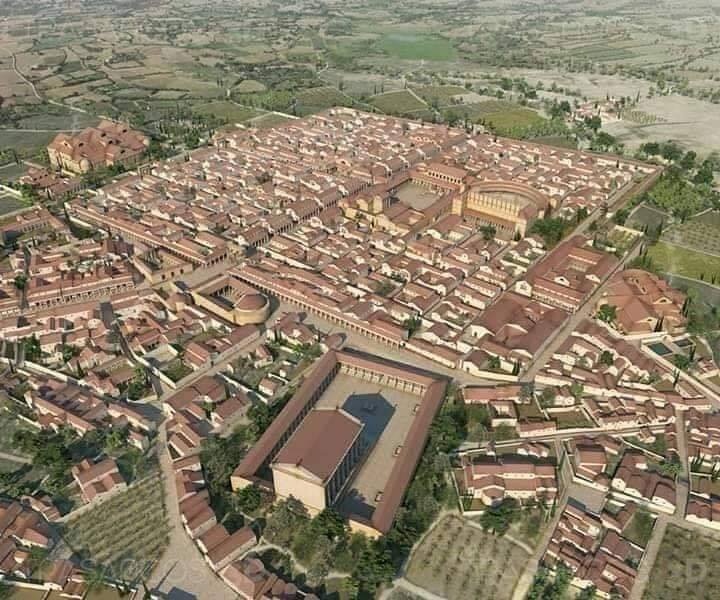Explore the Ancient Roman Ruins of Timgad :
Explore the Ancient Roman Ruins of Timgad
Nestled in the Aures Mountains of northeastern Algeria lies the remarkable ancient city of Timgad, a UNESCO World Heritage Site and one of the best-preserved examples of Roman urban planning. Founded in AD 100 by Emperor Trajan, Timgad—originally known as Thamugadi—was a thriving Roman colonial town built to serve as a military bastion and a symbol of Roman dominance in North Africa. Today, it stands as an extraordinary destination for history enthusiasts and travelers alike.
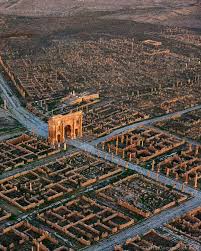
The Origins of Timgad
Timgad was established primarily as a settlement for Roman veterans, offering them land and a place to retire. The city’s layout reflects the quintessential Roman grid plan, featuring a rectangular arrangement of streets centered around a forum. Its design was a testament to Roman engineering and urban planning expertise, showcasing their ability to create organized and functional spaces for living, commerce, and governance.
Architectural Marvels
Visitors to Timgad are greeted by an array of stunning ruins that offer a glimpse into life during the Roman Empire. Key highlights include:
The Arch of Trajan: This iconic triumphal arch, standing at the entrance of the city, is an architectural masterpiece. Built to honor Emperor Trajan, it features intricate carvings and a commanding presence that symbolizes Roman grandeur.
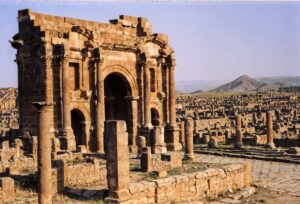
The Forum: The heart of civic life, the forum was the central public square where citizens gathered for political, commercial, and social activities. Surrounded by colonnades, it remains an impressive sight.
The Theater: With a capacity of around 3,500 spectators, the theater hosted a variety of performances, from plays to public events. Its excellent preservation allows visitors to imagine the lively gatherings that once took place here.
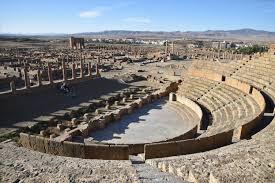
Public Baths: The well-maintained baths highlight the importance of hygiene and leisure in Roman society. Intricate mosaics and advanced heating systems demonstrate the sophistication of Roman engineering.
Residential Areas and Streets: Strolling through the remnants of homes and streets, visitors can observe the detailed layout of the city. The well-preserved stone pavements and drainage systems speak to the advanced infrastructure of the time.
The Significance of Timgad
Timgad’s ruins are not only a testament to Roman architectural prowess but also to their cultural and political influence. The city was a hub of trade and governance, serving as a gateway between the Roman Empire and the Berber tribes of North Africa. Its strategic location facilitated economic growth and cultural exchange, blending Roman traditions with local customs.
Visiting Timgad Today
Exploring Timgad is an awe-inspiring journey into the past. The site offers a unique opportunity to walk through streets that have remained largely intact for nearly two millennia. Visitors can:
Take Guided Tours: Knowledgeable guides bring the history of Timgad to life, sharing fascinating stories and insights about its construction and daily life during its peak.
Enjoy Panoramic Views: The elevated position of the ruins provides breathtaking views of the surrounding Aures Mountains and the Algerian landscape.
Discover Artifacts: The nearby museum houses a collection of artifacts, including statues, inscriptions, and tools, further enriching the understanding of Timgad’s history.
Practical Information for Travelers
To make the most of your visit to Timgad, consider the following tips:
Best Time to Visit: Spring and autumn offer pleasant weather for exploring the site.
Transportation: Timgad is accessible by road from major cities like Batna and Constantine. Hiring a local guide or joining a tour is recommended for a hassle-free experience.
What to Bring: Comfortable walking shoes, sun protection, and plenty of water are essential, as the site involves extensive walking and minimal shade.
Preserving Timgad for Future Generations
While Timgad stands as a remarkable testament to human history, preserving it requires ongoing efforts. Visitors are encouraged to respect the site by adhering to guidelines and avoiding actions that could damage the ruins. Supporting conservation initiatives and raising awareness about the importance of such heritage sites are vital steps in ensuring their longevity.
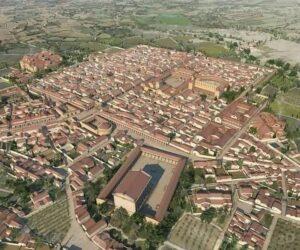
Conclusion
Timgad is more than just a collection of ancient ruins; it is a window into a bygone era of architectural brilliance, cultural richness, and historical significance. Whether you’re a history buff, an archaeology enthusiast, or simply a curious traveler, visiting Timgad is an unforgettable experience that transports you back to the height of the Roman Empire. As you wander through its streets and marvel at its enduring structures, you’ll gain a deeper appreciation for the ingenuity and legacy of ancient civilizations.

